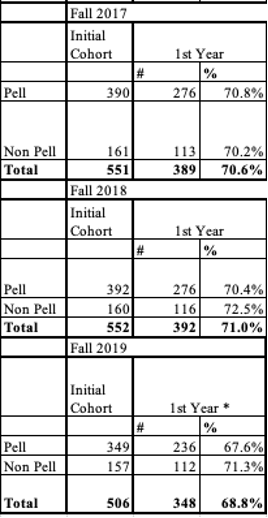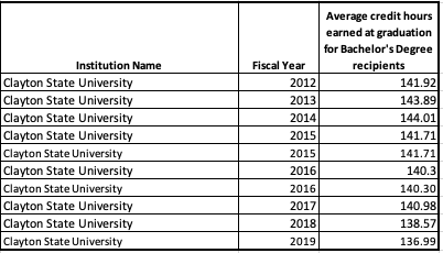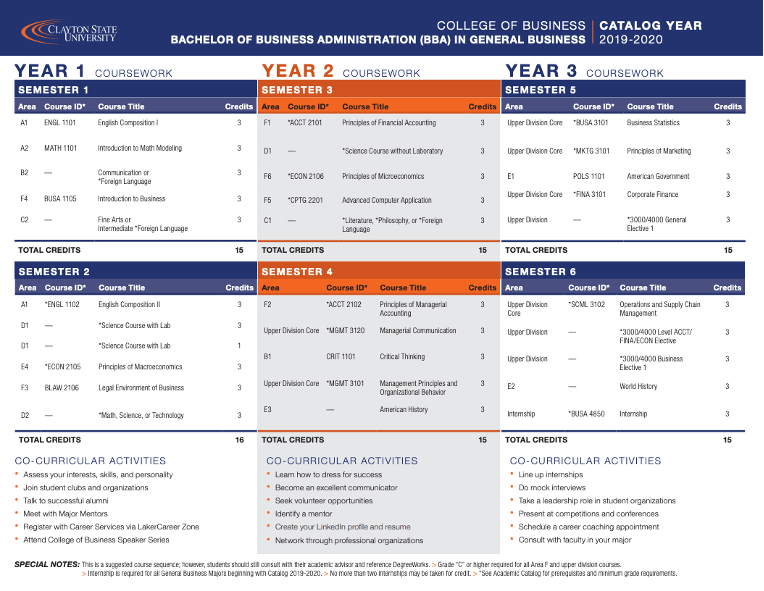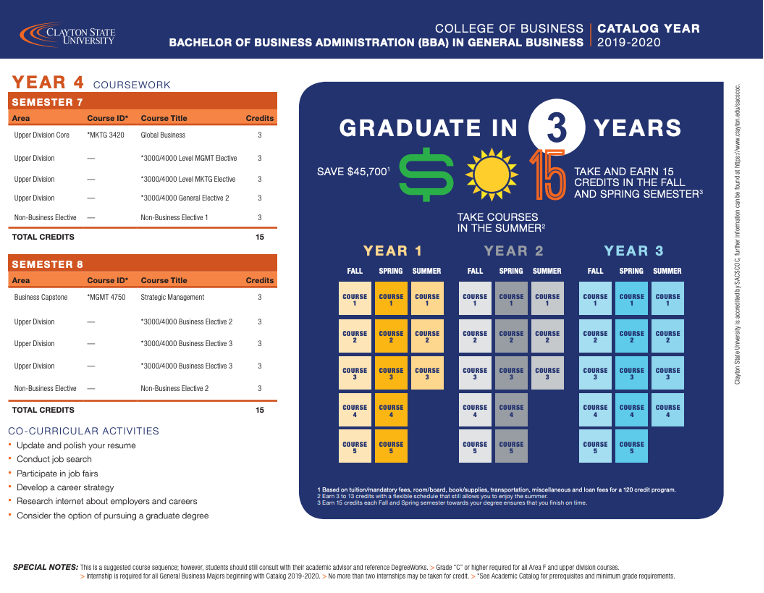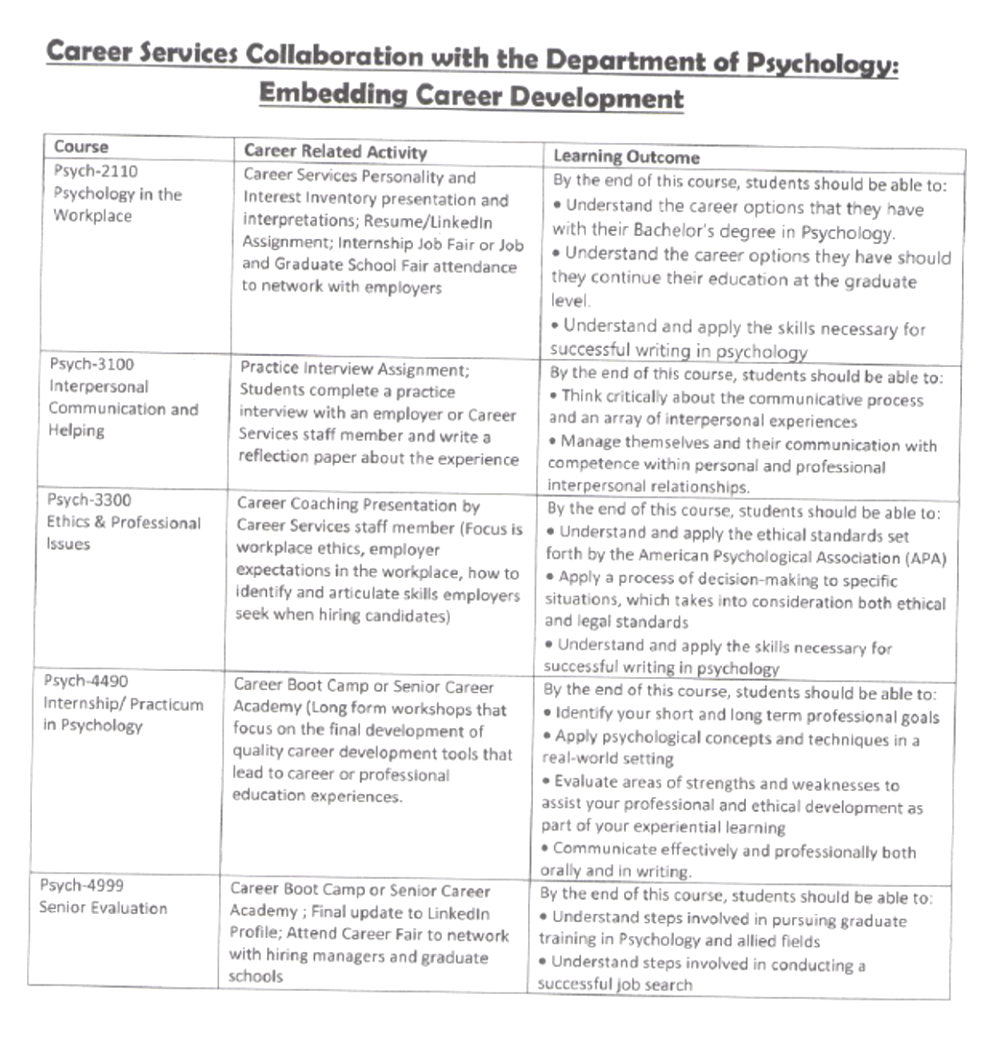Clayton State University Campus Plan Update 2020
Institutional Mission and Student Body Profile
About Clayton State University
Clayton State University (CSU) cultivates an environment of engaged, experienced-based learning, enriched by active community service, that prepares students of diverse ages and backgrounds to succeed in their lives and careers. Through a distinctive combination of proven and innovative methods of teaching and learning, Clayton State University will excel in preparing students from many walks of life to meet the challenges of living and working in a dynamic, global society. Clayton State University is committed to:
- Creating an outstanding educational experience that stimulates intellectual curiosity, critical thinking, and innovation.
- Engendering a spirit of openness, understanding, collaboration, and mutual respect throughout the University.
- Fostering learning that engages students, faculty, staff, alumni, and the greater community.
- Expanding and allocating resources strategically according to Mission and Values, and a five-year Strategic Plan, to support overall institutional effectiveness.
- Providing an inviting and supportive campus community for faculty, staff, and students.
- Repositioning Clayton State University in the higher education marketplace and beyond.
Clayton State University is accredited by the Southern Association of Colleges and Schools Commission on Colleges to award associate, baccalaureate, and master’s degrees.
Enrollment Trends
Clayton State’s headcount, full-time equivalent (FTE), and enrolled credit hours all increased in FY19 over FY18 and decreased in FY20 over FY19 as seen in the table below (Table 1). Fall 2020 has realized our third highest enrollment ever with the highest number of dual enrolled, new undergraduate traditional freshmen, and graduate students ever. Another data point contributing to our enrollment growth is our 9-percentage point increase in our 4-year graduation rate in three years. For FY20 we also realized a record number of degrees awarded (Table 2). FY21 is projected to have an increase in enrollment over 2% with slight increases in FTE and credit hours. The FTE and credit hour increases are less than then headcount increase due to a decrease in average credit hours for our dual enrollment students. Within FY20, summer 2020 enrollment was flat compared to the prior year, fall 2020 realized an increase of 2.5%, and the spring is projected to increase just over 2.5%. Overall, we anticipate realizing gains in fiscal year headcount, FTE, and credit hours for FY21.
Table 1
Table 2
Clayton State University Student Demographics
Clayton State is currently designated by the federal government as a Predominately Black Institution (PBI). For Fall 2020 38.7% of undergraduate students identified as first-generation on the FASFA. In addition, 67.1% of undergraduate students were Pell eligible. These numbers are consistent with undergraduate students that were enrolled for Fall 2019.
Benchmarking
We consider other State Universities to be our benchmarks for student success with the exceptions of Georgia College & State University and the University of North Georgia. Table 3 compares us to other State Universities for the Fall 2015 and Fall 2013 cohorts. Given our designation as a PBI, we aim to be the leader in the USG for retention and graduation rates amongst PBI designated institutions. For the Fall 2016 cohort we are projecting another increase to 16.7% for our 4-year graduation rate.
Table 3: Graduation Rate for State Colleges

Improvement Practices
Over the past five years Clayton State University had rededicated our efforts to improving the success outcomes for all of our students. The following sections represents many of the achievements as a result of this commitment.
Over the past three months leadership at Clayton State University has worked closely with our Institutional Research and Information Technology departments to become more agile in the way institutional data is reported, analyzed, and shared with the campus constituencies. These efforts have involved Academic Deans, Academic Department Chairs, Information Technology team members, and student support offices. From this work we have developed deeper understandings and actionable plans related to the following items:
- Utilization of D2L activity data to inform student engagement and outreach strategies;
- Mid-term grade distributions and the impact of changes to learning modalities;
- Disaggregated courses withdrawal reporting;
- Impact of first-year student success based on when students interact with student support offices; and
- Reporting on the impact of student characteristics (i.e., high school/county, Pell eligibility, race/ethnicity) on retention and graduation rates.
As a result of these efforts we have taken the following actions:
- Expanded Academic Department Chair self-service reporting ability to allow for deeper insights at the section and instructor level;
- Developed and identified a tracking mechanism for first-year students that have not been advised and that have not engaged with a student support office (i.e., Campus Life, Career Services, Tutoring, Recreation Center) which allows for more customized outreach efforts; and
- Integrated with the underlying D2L database to allow for better visualization of D2L activity within existing university applications and process (i.e. No Show reporting).
Our Strategic Plan 2022 identifies strategic priority number one as increasing enrollment, retention, and graduation rates. It outlines our first year IPEDS cohort rate to improve to 75% and our 4-year graduation rate to 15% and 6-year graduation rate to 40%. For the most recent IPEDS graduation cohort we are projecting a 4-year graduation rate of 17% which represents a 9-percentage point over three years. During this time period we have also eliminated the degree achievement gap between Pell and non-Pell eligible undergraduates (Table 4). Our first-year IPEDS retention rate had seen three years of consistent retention rate improvements, however, we are anticipating a drop in this rate for the Fall 2019 cohort. We conducted an analysis of this drop in our first-year retention rare and found that Pell eligible students retained at a lower rate than their non-Pell eligible peers (Table 5). This was after two straight years of removing this retention gap. Overall, we saw record 2-year, 3-year, and 4-year retention rates. Our latest CCG data report also demonstrated that we have realized a decrease of 4.23 of average credit hours earned at graduation (-4.87% change) (Table 6). For the upcoming year our focus is on utilizing many of the data insights described above to make changes for spring 2021.
Table 4: Clayton Statue University Retention and Graduation Rate by Pell Eligibility
Table 5: Clayton State University First-Year Retention Rate by Pell Eligibility
Table 6: Clayton State University Average Earned Hours for Graduates
Momentum Update: Observations and Next Steps
Section 3.1 Existing Momentum Work
Purposeful Choice
|
Strategy or activity |
Embedding Purposeful Choice into our Freshman Seminar Course |
|
Summary of Activities |
For Fall 2019 we successfully embedded purposeful choice in our freshmen seminar course. This was done in collaboration with the Office of Career Services. |
|
Outcomes/Measures of progress |
We conducted a pre- and post-test of students to determine outcomes and feelings associated with purposeful program choice. We found statistically significant improvement in this area (p-value >.05) for all students in the seminar course. |
|
Lessons Learned and Plans for the Future |
For a variety of reasons only 70% of our incoming freshmen end up enrolling in a first-year seminar course. This approach also failed to capture our transfer students. Moreover, many of our academic departments are moving toward embedding career within their academic programs. Therefore, we decided to integrate this approach with our career embedded initiative described in section 3.2. |
|
Changes because of COVID-19 |
Since the career embedded approach ensures that all of our students receive the benefits of purposeful program choice over the course of their studies we decided and the state budget reduction that resulted in us eliminating our freshman seminar instructor stipends we have made the decision to focus on purposeful program choice as part of our career embedded initiative. |
|
Strategy or activity |
Orientation Activities |
|
Summary of Activities |
We sought to improve the accessibility of materials and activities designed to support purposeful program choice remained accessible to students after orientation. The movement to a virtual orientation coincided with this activity. |
|
Outcomes/Measures of progress |
All incoming students automatically received a customized link to a video around their focus area within 24 hours of signing up for orientation. These videos included information that was developed by academic departments around the connection between the student’s major and the broader focus area, key courses in their first year, and information related to recommended co-curricular activities. Upon completion of a video students completed a survey regarding their interests for the fall semester. Academic advisors pre-built the student’s schedule and emailed the student their guided pathway worksheet with their schedule. Students were then invited to schedule a follow-up academic advising meeting. |
|
Lessons Learned and Plans for the Future |
Our plans for the future involve further integrating all of this information into one location that students can access as part their major exploration process. We also plan in the future to assess major changes to better understand patterns within specific majors and if there are key markers that would allow for proactive intervention. |
|
Changes because of COVID-19 |
COVID-19 necessitated many changes to how this was implemented for fall 2020. Over the period of two months our online orientation program was completely reimagined to ensure we delivered a program that met our learning outcomes while also was appropriate for a virtual environment. This included the development interactive sessions and recorded sessions. Our yield rate to the fall semester for students that participated in our online orientation remained above 90%. With the anticipation of continuing virtual orientations for the near future the biggest need is the development of a central repository for all of the resources that we have developed to support purposeful program choice and major exploration. |
Transparent Pathways
|
Strategy or activity |
4-Year Guided Pathways with Co-Curricular Activities (figure 1) |
|
Summary of Activities |
In collaboration with Deans, Department Chairs, Academic Advisors, and Student Affairs customized 4-year guided pathways were developed for every major and these documents were electronically delivered to all incoming students at orientation. |
|
Outcomes/Measures of progress |
As of fall 2020 all majors have 4-year guided pathways developed. Our plans for the 2021 is to review and update the pathways to ensure modifications to curriculum are captured as well as expand co-curricular options to more intentionally involve campus life and student activities (i.e, leadership development). This includes the need to develop an effective tracking mechanism (i.e., co-curricular transcript). This is described further in section 3.2. |
|
Lessons Learned and Plans for the Future |
These pathways are helpful for traditional first-year students that do not have a significant number of transfer hours from Advanced Placement or Dual Enrollment. They also help set the expectation of related enrollment initiatives (i.e., 15-to-finish, summer enrollment) for all students. We have a large percentage of transfer students, many of which have attended more than one university and non-USG institutions, these pathways become less effective when working with these students. However, we believe there is value in the identifying the co-curricular progression to facilitate conversations for these transfer students to ensure they are tracking toward completing both their major requirements but also co-curricular enrichment activities. |
|
Changes because of COVID-19 |
We need to further flush out co-curricular activities and the potential identification of a solution that would allow for a true co-curricular transcript. Moreover, we need to find a way to make these pathways sheets easily accessible to current and prospective students. We are looking to model our site off of http://degrees.unm.edu/. |
Figure 1
|
Strategy or activity |
Math, English, and 15 credits for Incoming Students |
|
Summary of Activities |
For fall 2020 we changed to a model of pre-registering all incoming first-year students. This allowed us to default students to 15+ credits and ensure the appropriate Math pathway courses rather than these being perceived by students are recommendations. |
|
Outcomes/Measures of progress |
For fall 2020 we saw a 6.1 percentage point increase in freshmen currently being on track to complete their Math, English, and earn 30 credits by the end of their first year (62.5%). Much of this gain is attributed to the 14.4 percentage point increase of fall freshmen attempting 15 or more credits in the fall semester. Overall, 87.3% of our incoming freshmen were registered as full-time (.7 percentage point increase from fall 2019) of which 52.1% of those students are enrolled in 15 credit hours or more for the fall. The increase in students attempting 15 or more credits is attributed to the move to pre-registration of all incoming first-year students to 15 credits as the default rather than a recommendation. However, we did realize significant declines in students being on track to complete English and Math in the fall semester (table 6). |
|
Lessons Learned and Plans for the Future |
We attribute this decline in Math and English to the following factors: 19%in new undergraduate enrollment, continued growth of our Dual Enrollment program, and the move to test optional that resulted in a significant increase in students requiring either the co-requisite English or co-requisite Math courses further reducing instructional capacity. Priority was given to fall freshmen needing the co-requisite English and STEM pathway majors needing MATH 1101 or MATH 1111. We plan to continue to utilize the summer semester to ensure students are able to complete their Math and English sequence as part of their first year of enrollment. |
|
Changes because of COVID-19 |
With the decision that we will be test optional for fall 2021 and with no reported changes to Dual Enrollment we anticipate needing to be more strategic in allocating resources to handle the likely continued increase in demand for Math and English. Moving forward we look to use our reporting solutions dashboard functionality to better measure ongoing enrollment in Math and English coursework. |
Table 6: Fall Freshmen Enrolled or Earned Credit in English and Math
|
Fall |
% English |
% Math |
|
2016 |
96.4% |
97.9% |
|
2017 |
95.1% |
94.4% |
|
2018 |
82.2% |
85.5% |
|
2019 |
97.2% |
93.3% |
|
2020 |
83.9% |
63.7% |
Academic Mindset
|
Strategy or activity |
Faculty Mindset |
|
Summary of Activities |
For Fall 2019 the topic of academic mindset was the focus of faculty planning week |
|
Outcomes/Measures of progress |
Over 25 percent of our faculty have participated in additional training on inclusiveness and helping all students feel as sense of belonging at the University |
|
Lessons Learned and Plans for the Future |
Clayton State has a significant population of first generation college students from underrepresented groups. Increasing faculty awareness and use of strategies to promote an environment of belonging and efficacy in the classroom is critical to student success. This work dovetails with our current work related to diversity and inclusion. This fall, we incentivized faculty participation in a MOOC offered by Cornell University on Teaching and Learning in the Diverse Classroom which includes modules focusing on faculty mindset. We also promoted our own faculty developed workshops on racial equity. Faculty will be sharing strategies they integrated into their courses with through our Center for Excellence in Learning and Teaching. At the University level, we created a campus wide Committee for Inclusion and Engagement. This group helps develop and communicate activities across campus that promote a sense of belonging. We have also added a new module to our orientation for new faculty called “Our Stories, Our Community” which included a presentation on our student profile and a conversation with current CSU students. This session is designed to begin shaping the perceptions of our new faculty on the promise and capability of our students. |
|
Changes because of COVID-19 |
As a result of COVID, all of the training and committee work has been virtual. The use of TEAMS facilitates these activities and may actually increase participation for some since it can be more flexible. |
Other
|
Strategy or activity |
Increasing Campus Awareness and Integration of Momentum Work |
|
Summary of Activities |
The momentum summit survey demonstrated that while many directors were aware of the momentum initiative, they were often only aware of the specific parts of the initiative that impacted their unit. In some cases, they responded they were unaware of the initiative but then identified components of the initiative later in the survey. We committed to providing updates via our administrative council on our work and progress. This includes sharing summaries of the documents we submitted coming out of the January 2020 Momentum Summit. |
|
Outcomes/Measures of progress |
Anecdotally the administrative council presentation was well received. As a result of this presentation and the January Momentum Summit we have further expanded our working group to include additional stakeholders. Progress will be measured on future surveys to determine if there is an increase level of awareness of the initiative. |
|
Lessons Learned and Plans for the Future |
We cannot overcommunicate our work. We also heard a lot of about the desire to more directly connect these efforts to existing initiatives. We anticipate that as we restart this work it will critical to intentionally connect the Momentum initiative to our strategic plan |
|
Changes because of COVID-19 |
We had to quickly pivot our focus from expanding the momentum initiative toward maintain our existing efforts in order to expand efforts around student success in a virtual environment. We are hopeful that we will be able to reengage with our Momentum Summit III plan starting in the spring semester. |
|
Strategy or activity |
Policy Audit |
|
Summary of Activities |
We identified a team to develop a policy audit process. The audit will help us review policies which impact student enrollment. |
|
Outcomes/Measures of progress |
To be determined |
|
Lessons Learned and Plans for the Future |
We have formed a committee and anticipate this group will restart their efforts this spring. |
|
Changes because of COVID-19 |
This activity was put on hold due to COVID-19. |
General Overview and Observations
COVID-19 had a significant impact on our work. Our commitment to the principles of the momentum year remains unwavering, although delayed is some case or reimagine in others due to the pandemic. We identified action items coming out of the January 2020 Momentum Summit. The pandemic required us to pause many of those actions to focus on campus safety and reopening plans and student success in the virtual environement. We are hopeful that starting in spring 2021 the pandemic will have receded enough that we will be able to dedicate institutional resources to move forward with the action items developed at the summit. These key action items related to purpose, mindset, and pathways are described in section 3.2.
The transition to the virtual environment has driven us to be more intentional about identifying and tracking student success markers throughout the semester rather than as a semester post-mortem approach. It also led us to democratize access to data to empower department chairs and directors of offices to feel an increased sense of ownership and understanding of the Momentum initiatives.
Section 3.2 Follow up from Momentum Summit III - “Campus-Wide” Momentum Approach Activities (Beyond the Classroom)
Purpose
|
Priority Work |
Career Embedded within Majors |
|
Description of Activities |
Currently working towards the integration of career readiness modules into campus-wide academic curriculum |
|
Activity status and plans for 2020 |
We currently have completely embedded career readiness modules into all majors within the College of Business, and three departments, Psychology (Figure 2), Healthcare Management, and Health Sciences. Each academic area has identified a set of career modules for selected courses based on student learning outcomes for specific majors across a student's educational course plan. Pre-COVID-19 the plan was to increase the number of departments to eight. We have reengaged with this effort and hope to have 15 new majors on board by Fall 2021. |
|
Lessons Learned |
Early results show that students are feeling more confident in their chances of being employed as a result of their engagement in career readiness, experiential learning and their college degree. To date the following number students have completed the Career Readiness modules: COB-3655; Psychology: 2,522; HCMG/HSCI 1,165. |
Figure 2
Mindset
|
Priority Work |
Faculty Mindset |
|
Description of Activities |
Faculty training and University collaboration |
|
Activity status and plans for 2020 |
As a following up to the MOOC on Teaching and Learning in the Diverse Classroom, faculty will be paired with other participants to share their work from the course. Participants will also share their new strategies with their academic department and the Center for Excellence in Learning and Teaching. During the Spring Semester, there will be a forum for all participants to meet and discuss next steps for promoting inclusivity and belonging on campus. |
|
Lessons Learned |
We have found that using a combination of external training and faculty-to-faculty interaction with peers increases receptivity to new pedagogical strategies. Faculty appreciate the information shared by “experts,” but they like to process and refine the strategies through conversations with their peers. |
Pathways
|
Priority Work |
Co-curricular Transcripts |
|
Description of Activities |
Our Vice President of Student Affairs and Vice President of Academic Affairs co-chaired a committee with the charge of developing a co-curricular transcript. |
|
Activity status and plans for 2020 |
We are exploring a software solution that allows for student event tracking to be in the same database for which the co-curricular transcript is generated. |
|
Lessons Learned |
Our efforts around career embedded development activities have proven very successful and we are hopeful to utilize a similar approach in developing co-curricular activities for each major. |
Student Success and Completion Team
Please provide the names and titles for the individuals on your campus responsible for implementing, monitoring, and evaluating your Student Success and Completion Strategies.
|
Name |
Title |
|
|
Eric Tack |
Assistant Vice President of Student Success |
|
|
Stephen Schultheis |
Vice President of Enrollment Management and Student Success |
|
|
Shakeer Abdullah |
Vice President of Student Affairs |
|
|
Kevin Demmitt |
Vice President of Academic Affairs and Provost |
|
|
Sherwin James |
Director, Center for Advising & Retention |
|
|
Jada Mitchell |
Director, Center for Academic Success |
|
|
Natasha Hutson |
Executive Director, Student Activities and Campus Life |
|
|
J. Celeste Walley-Jean |
Dean, Graduate School and Inclusive Engagement |




